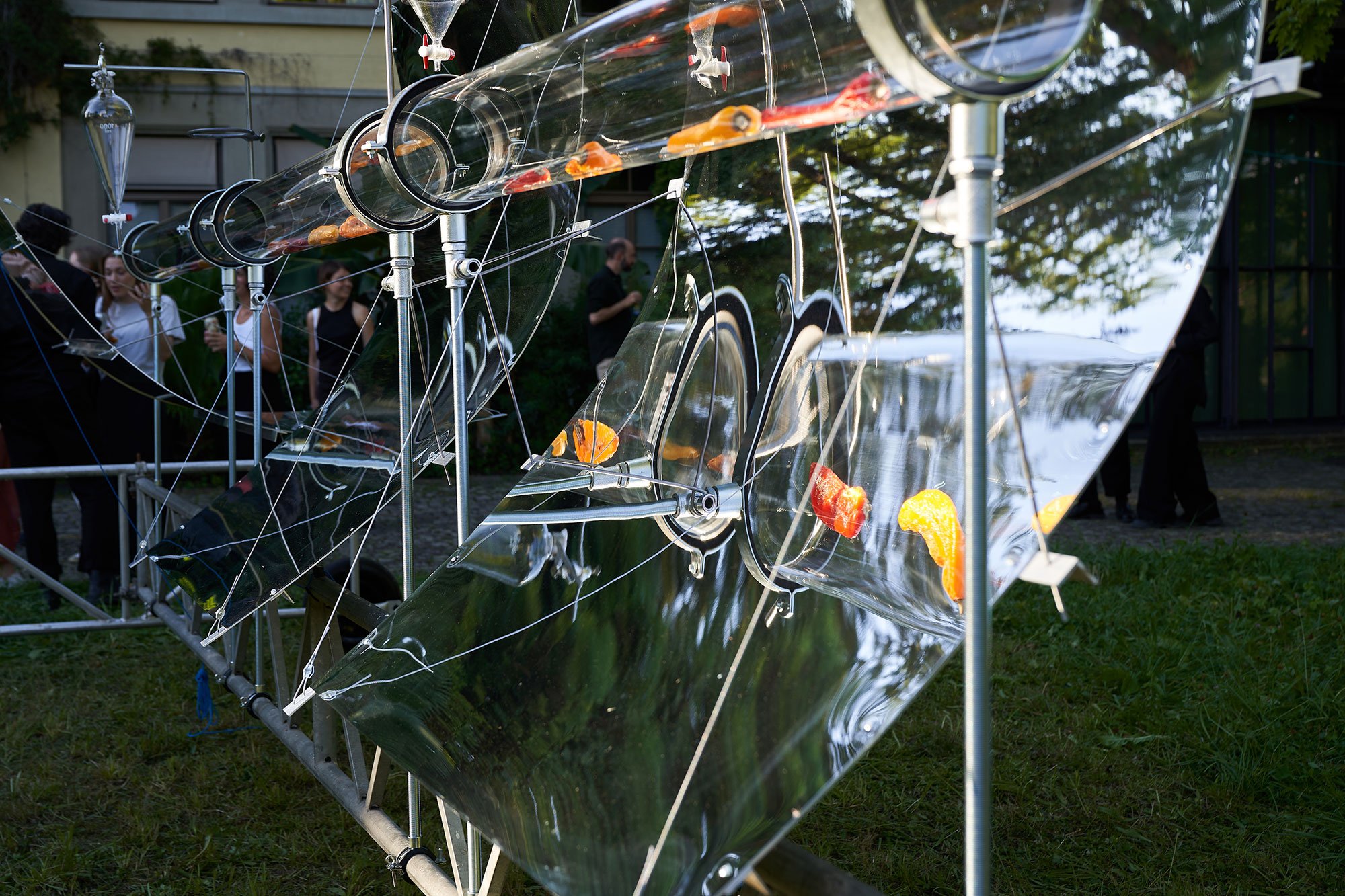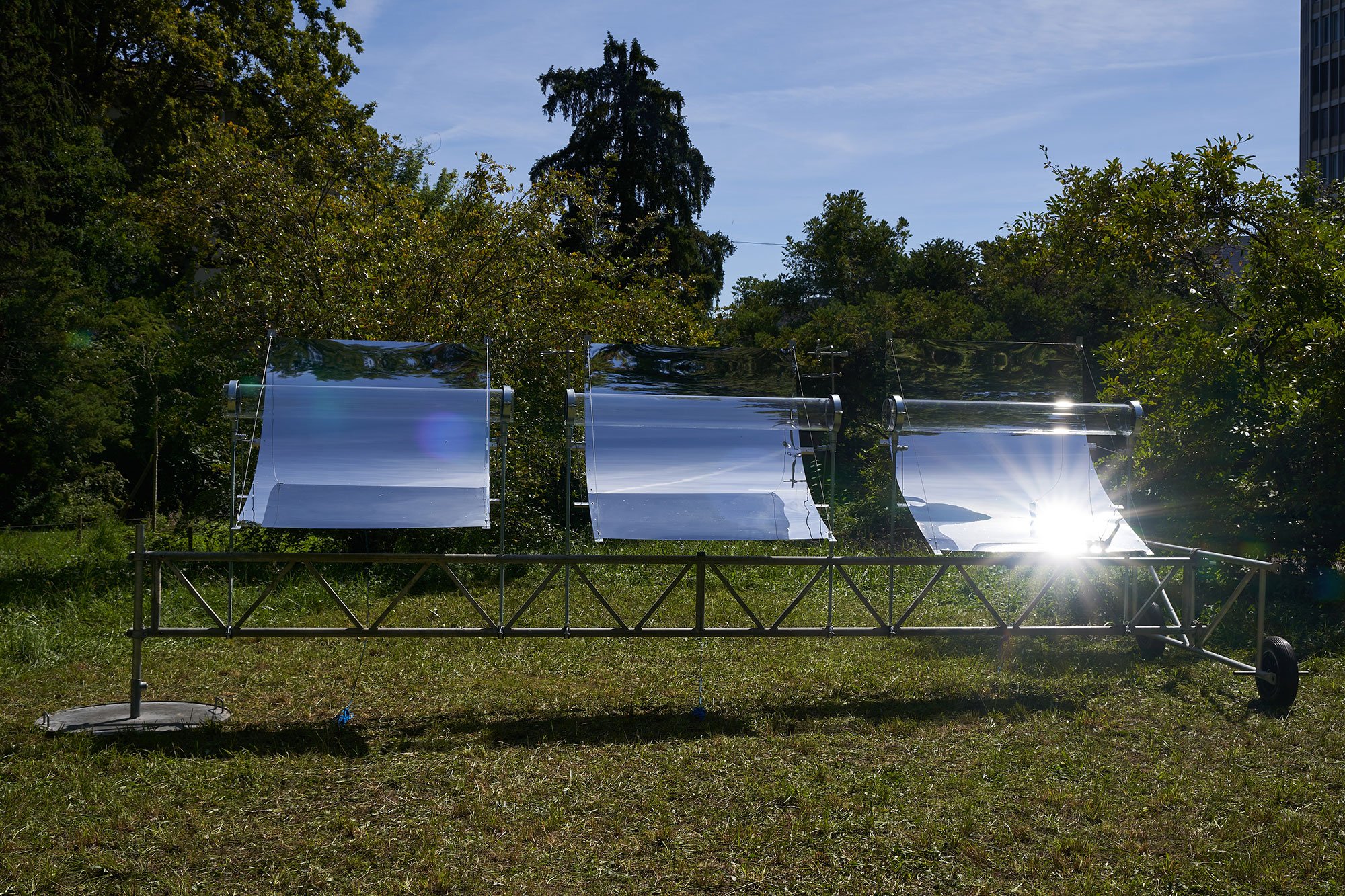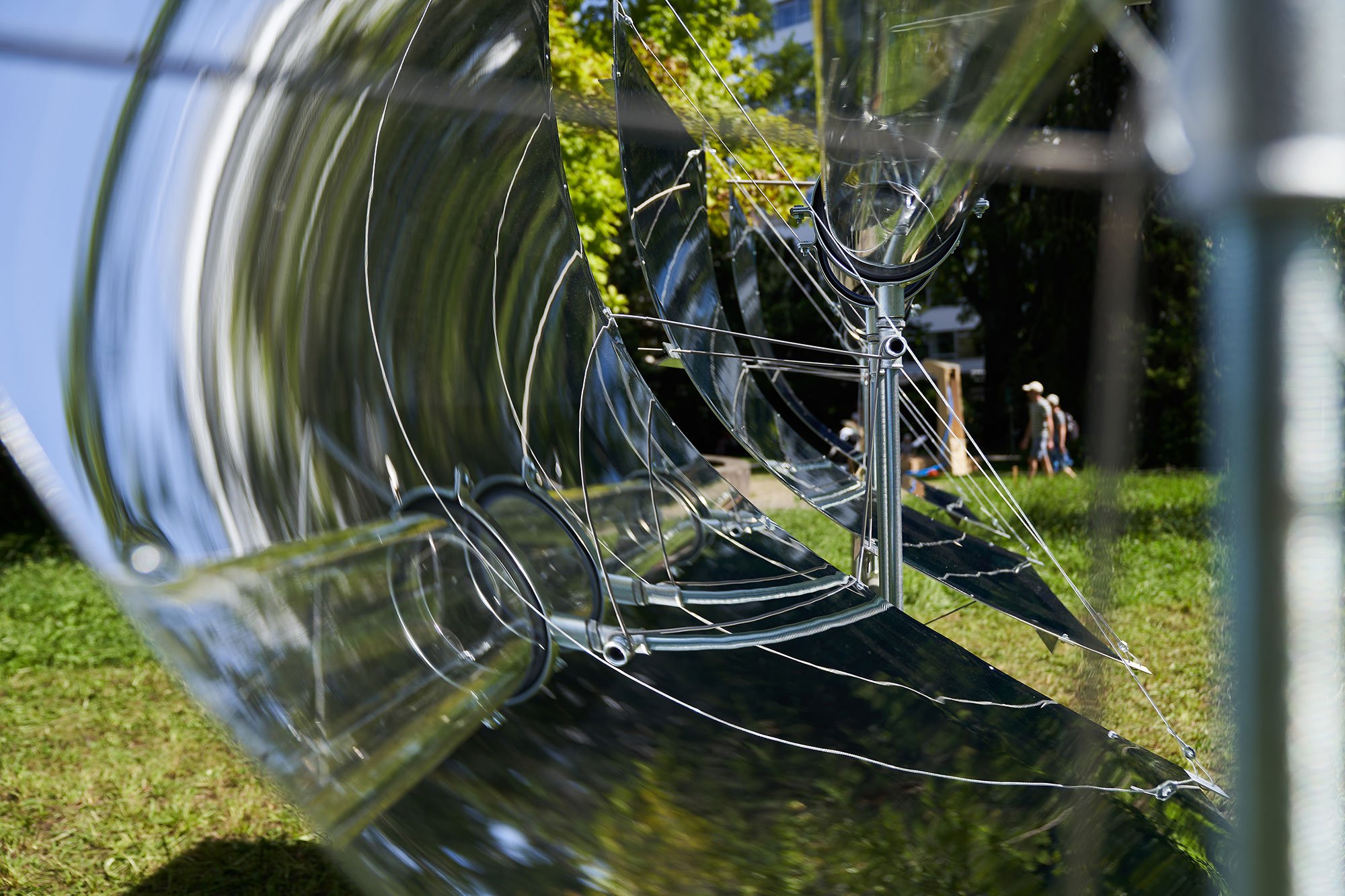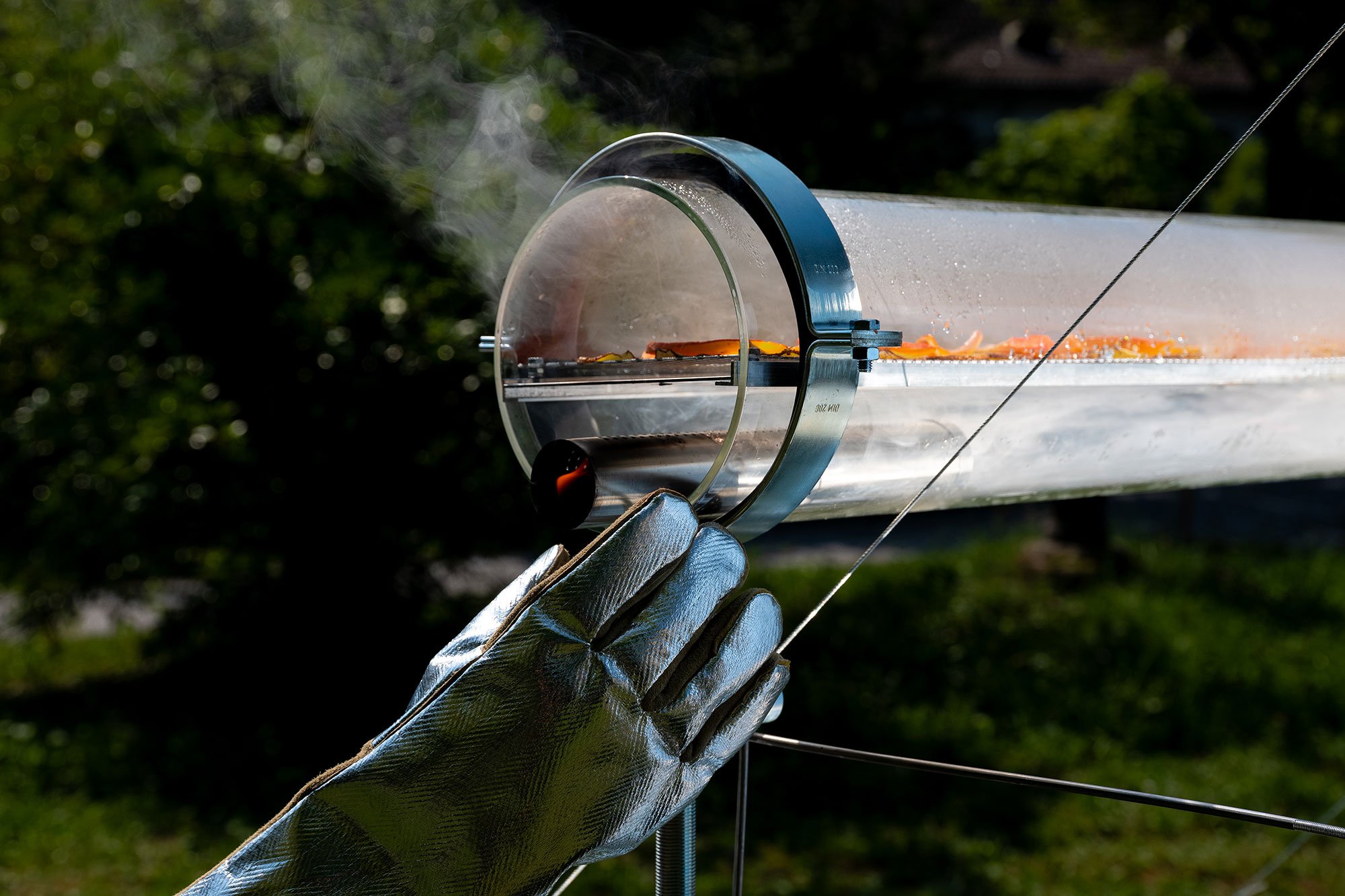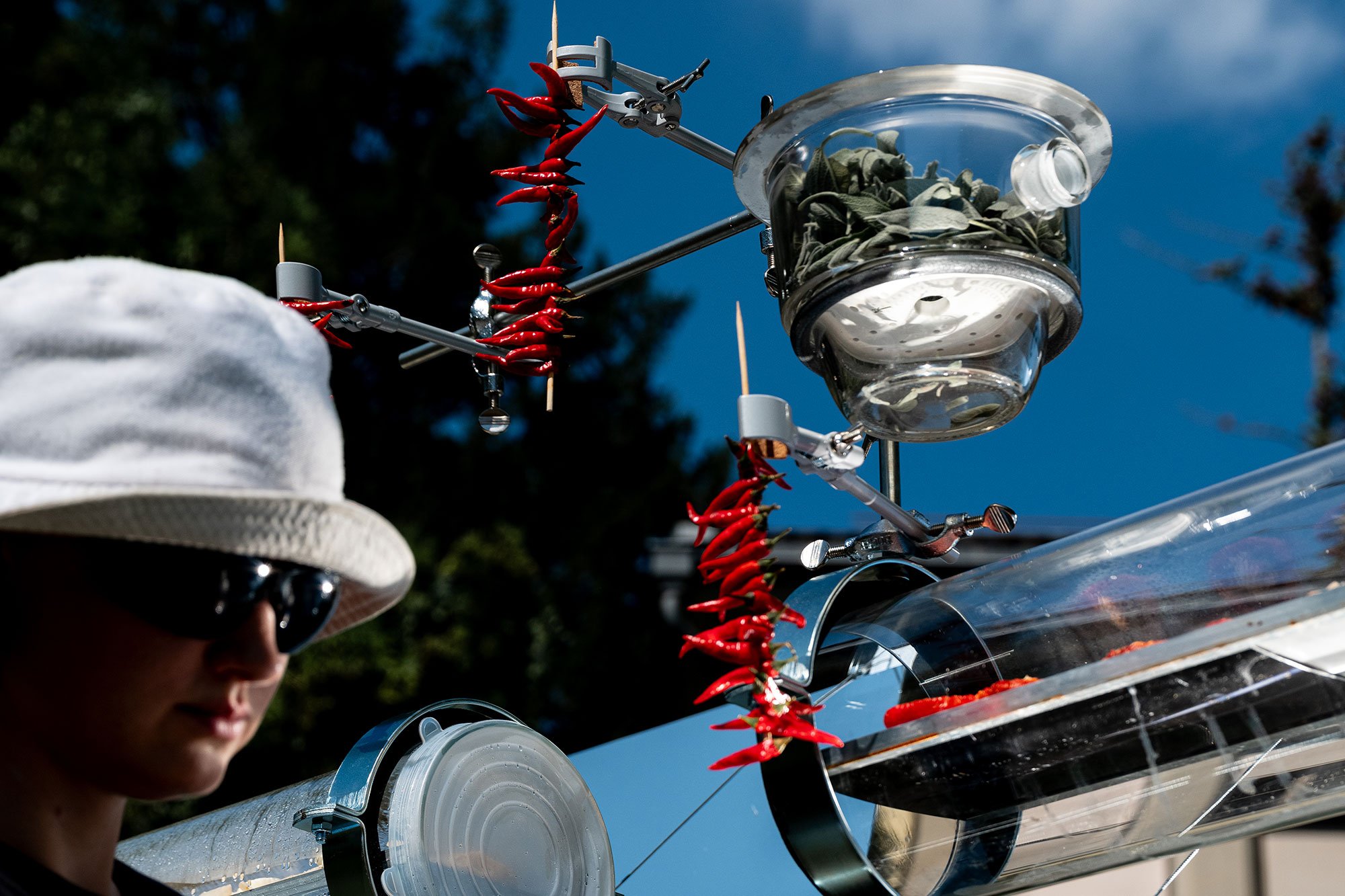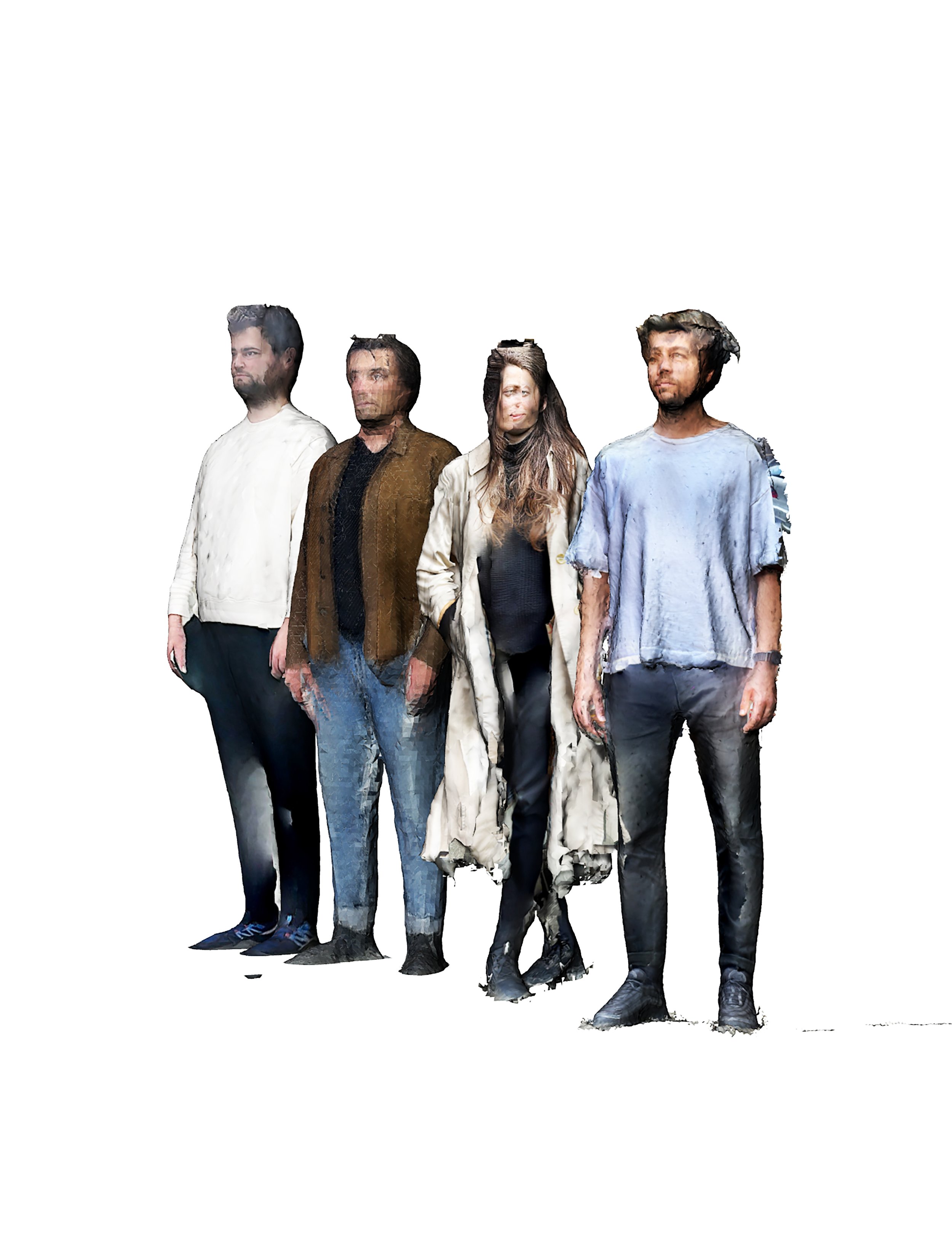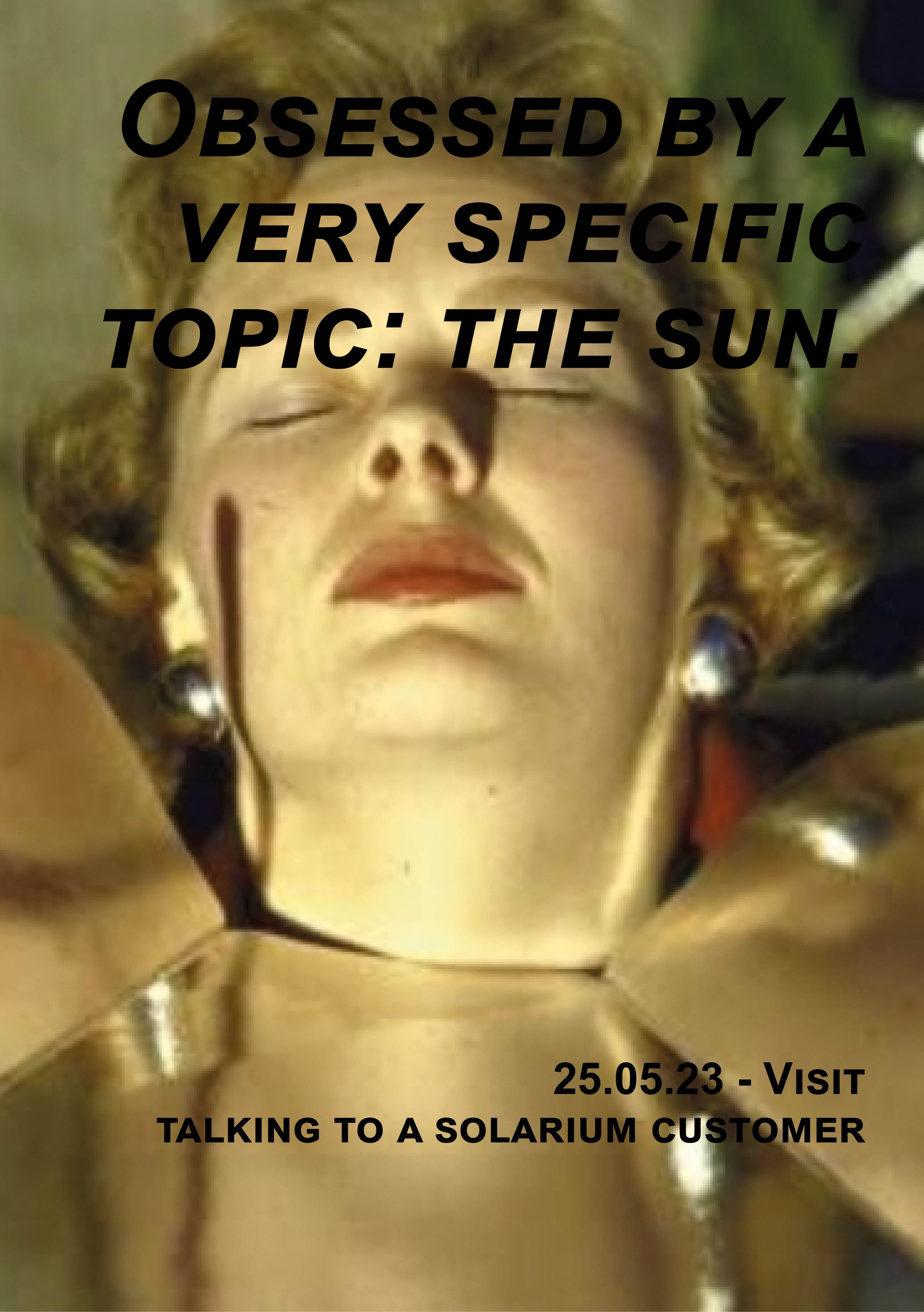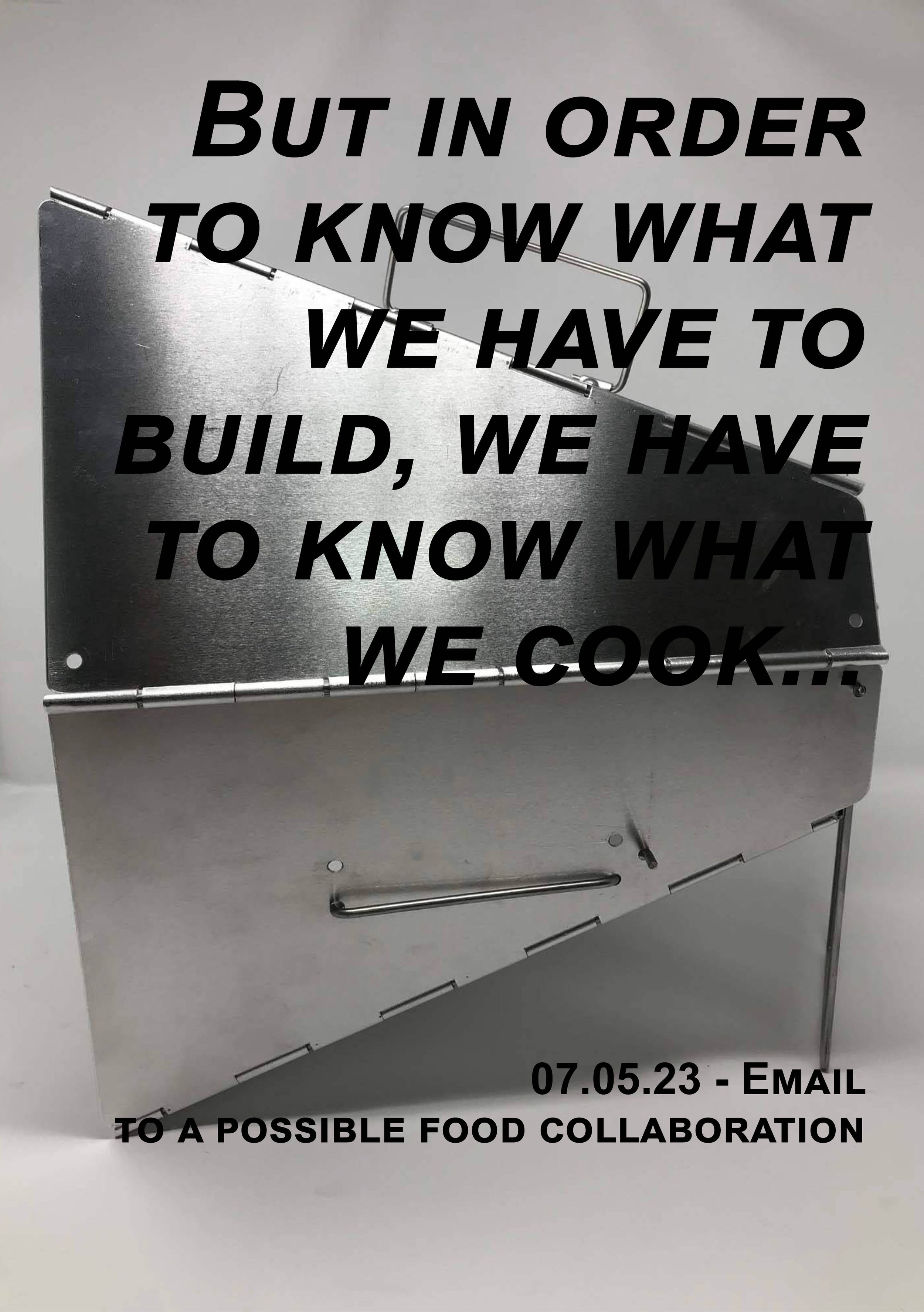ELECTRYON – ALIAS & COMTE/MEUWLY
ELECTRYON
ALIAS & COMTE/MEUWLY
Ein mobiler Solarofen erhitzt Wasser, das zum Kochen benutzt werden kann, und wird dabei zu einem sozialen Treffpunkt. Die Entdeckung des Umspannwerks unter dem Alten Botanischen Garten UZH veranlasste ALIAS & COMTE/MEUWLY dazu, die Distanz zwischen der Energieerzeugung und dem -verbrauch zu hinterfragen. Im Rahmen verschiedener Veranstaltungen erhalten die Besuchenden die Möglichkeit, sich mit der Solarenergie auseinanderzusetzen, die die Installation produziert.
Es ist ganz einfach: Wir werden der Sonne folgen und uns ihrer Kraft hingeben. Wir werden uns mit ihr bewegen, uns unter ihr aufhalten, ihre Energie sammeln, sie in Wärme umwandeln, Wasser damit kochen, Brot backen, unser Essen geniessen und weiterziehen. Immer wenn sie untergeht, ist es Zeit zu gehen. Wenn die Sonne wieder da ist, werden wir uns versammeln, sie umarmen und den so seltenen Sonnenschein in diesem düsteren botanischen Garten feiern.
Aufgrund der in den 1970er-Jahren erfolgten Verlegung des botanischen Gartens an den Stadtrand, konnte der 1834 auf den Mauern der barocken Bastion «Zur Katz» angelegte Garten in ein Erholungsgebiet umgewandelt werden. Gleichzeitig errichtete das Elektrizitätswerk der Stadt Zürich ein Umspannwerk unter der Bastion: zwei Tunnel mit drei Transformatoren, die den Strombedarf der Innenstadt decken. Dabei verbirgt die malerische Landschaft des Gartens die Energieverteilung – nur kleine Öffnungen und Zugänge geben den Blick auf die unterirdischen Maschinen frei.
«ELECTRYON» hinterfragt die Distanz zwischen Energieerzeugung und -verbrauch. Während einer Reihe von Veranstaltungen am 8., 9. und 10. September werden die Besuchenden auf partizipative Weise in die Energieerzeugung eingeführt. Das Herzstück der Installation ist ein solarbetriebener Wärmegenerator, der die Besucher:innen dazu einlädt, sich zu versammeln, den Kochprozess zu verfolgen und die Mahlzeit zu genießen. Die mobile Solarküche wird von Kitchuan aktiviert. Sie besteht aus einem Parabolspiegel, der die Sonnenstrahlen bündelt und die Wärme zum Kochen speichert. Die Installation nutzt die vor Ort vorhandene Energie als Gestaltungsmittel und betreibt damit ein performatives Gerät.
ELECTRYON SOLAR COOKING LABORATORY
Performaties Kochen von Kitchuan
Layering time - techniques - taste
Über 3 Tage hinweg führt Kitchuan ein experimentelles Labor des Solarkochens durch. Die Zubereitung eines Gerichts wird in 3 Teile zerlegt um seine Schichten aufzubauen. Es wird getrocknet, geschnitten, mariniert, geröstet, gedämpft, geräuchert, geknetet und gebacken. Bei der Auswahl der Gemüse orientiert sich Kitchuan an der Sonne, je mehr Sonne das Gemüse zum Wachsen benötigte, desto besser. In den Experimenten werde Veränderungen in Struktur und Textur angestrebt, indem durch Trocknen und Wässern Geschmacksrichtungen identifiziert werden.
Kitchuan baut ein Ritual um das Kochen herum: Die Tagesstunden beeinflussen die Stärke, Kraft und Temperatur.
Das finale Gericht verwendet als Basis einen ungarischen Pompos, eine Art Kartoffel-Weizen-Teig. Die Basis besteht aus Sonnengemüse, darauf getrocknete Tomaten und Kräuteröl.
Sonnenaufgang 06:54 06:55 06:57
Sonnenuntergang 19:55 19:49 19:47
Das Labor ist den ganzen Tag über geöffnet. Schliesst Euch bei den Experimenten an oder am letzten Tag zum Festmahl.
08 09 23 Vorbereitung
09 09 23 Intensivierung
10 09 23 Das Festmahl (ab 17:00 Uhr)
Projektteam: Antoine Berchier, Arnaud Bostelmann, Adrien Comte, Lorenza Donati, Shen He, Lewis Horkulak, Nicolas König, Blanka Major, Pierre Marmy, Adrien Meuwly, Juliette Martin, Ansgar Stadler
Unterstützt durch die Dr. Adolf Streuli Stiftung
A mobile solar oven heats water that can be used for cooking, becoming a social gathering place in the process. The discovery of the substation under the Old Botanical Garden UZH led ALIAS & COMTE/MEUWLY to question the distance between energy production and consumption. Through various events, visitors are given the opportunity to engage with the solar energy produced by the installation.
It's quite simple: we will follow the sun and surrender to its power. We will move alongside it, stay beneath it, harness its energy, convert it into heat, boil water, bake bread, enjoy our meals, and move on. When it sets, it's time to depart. And when the sun returns, we will gather, embrace it, and celebrate the rarity of sunshine in this somber botanical garden.
As a result of the relocation of the botanical garden to the city outskirts in the 1970s, the garden, originally established in 1834 on the walls of the Baroque bastion “Zur Katz”, was transformed into a recreational area. Simultaneously, the city of Zurich’s electricity company constructed a substation beneath the bastion: two tunnels housing three transformers that meet the power needs of the city center. The picturesque landscape of the garden conceals the energy distribution, with only small openings and access points providing glimpses of the subterranean machinery.
“Electryon” invites you to engage with energy. During a series of events on the 8th, 9th and 10th of September, visitors are introduced to energy production in a participatory way. At the core of the installation is a solar-powered heat generator, inviting visitors to gather, follow the cooking process and enjoy the meal. The movable solar kitchen will be activated by Kitchuan. Composed of a parabolic mirror that focuses sunlight and stores heat for cooking, the installation uses on-site energy as a design element and operates as a performative device.
ELECTRYON SOLAR COOKING LABORATORY
Performative cooking by Kitchuan
layering time - techniques - taste
Over 3 days, an experimental laboratory of solar cooking is taking place. The making of a dish will be deconstructed into 3 parts to build up its layers. There will be drying, cutting, marinating, roasting, steaming, smoking, kneading and baking. In choosing the vegetables Kitchuan orient towards the sun, the more sun the vegetables needed to grow the better. In the experiments changes in structure and texture are aimed for, identifying tastes through dehydrating and hydrating.
Kitchuan will build a ritual around cooking: The hours of the day influence the strength, power and temperature.
The final dish uses as a base a Hungarian Pompos, a type of potato-wheat-dough. The base is made of sun vegetables, on top dried tomatoes and herb oil.
Sunrise 06:54 06:55 06:57
Sunset 19:55 19:49 19:47
The laboratory is open throughout the day, join to experiment, or join for the feast on the last day.
08 09 23 Preparation
09 09 23 Intensification
10 09 23 The Feast (from 17:00)
Project team: Antoine Berchier, Arnaud Bostelmann, Adrien Comte, Lorenza Donati, Shen He, Lewis Horkulak, Nicolas König, Blanka Major, Pierre Marmy, Adrien Meuwly, Juliette Martin, Ansgar Stadler
Supported by Dr. Adolf Streuli Stiftung
Curators’ Comment
Wir beziehen Energie einfach und unkompliziert - wie selbstverständlich, aus der Steckdose. Dies ohne direkte Verbindung zu unserem Sonnensystem, der ursprünglichen elementaren Energie. Ein Team von Architekt:innen und Expert:innen nutzen in einer Installation die Energie der Sonne und setzen sie für die Zu- und Verarbeitung von Nahrungsmitteln ein. Dieses Vorhaben zwischen Low- und High-Tech und zwischen Forschung und Tradition hat mich begeistert. Eine Installation, die Besuchende zudem in einem Rahmenprogramm teilhaben lässt und dabei eine Auseinandersetzung und Diskussionen anregt. All dies zeigt uns eine andere Perspektive auf und weist auf unseren Umgang mit Energie hin (Andreas Saxer)
We obtain energy simply and straightforwardly - as a matter of course, from the power outlet. This is done without a direct connection to our solar system, the original elemental source of energy. A team of architects and experts is using the energy of the sun in an installation and applying it for the preparation and processing of food. This project between low and high tech and between research and tradition excited me. An installation that also allows visitors to participate in a supporting program, stimulating debate and discussion. All this shows us a different perspective and points to our handling of energy. (Andreas Saxer).
Fragebogen Questionary
Wie sieht Euer Arbeitsplatz aus?
Ein Ort des Experimentierens, Kabel und Bildschirme, Bücher, jede Menge Material, Prototypen und Modelle oder ein zufälliges Objekt aus Latex. Irgendwo zwischen einem anonymen Raum und einer Werkstatt.
Welche Themen beschäftigen Euch in Eurer Arbeit?
Spezifische und präzise Reaktionen auf (ultra-)zeitgenössische Situationen. Angetrieben von den unkontrollierten Ergebnissen des Prozesses des Lesens und Neuschreibens der kontextuellen Narrativen.
Welche Veränderungen erlebt Ihr in der Designwelt?
Ein wachsendes Bewusstsein und Interesse dafür, was Dinge sind und woher sie kommen. Wie soll man handeln? Der Prozess hat tendenziell einen höheren Stellenwert als das singuläre, losgelöste Objekt.
Wo findet Ihr Inspiration?
In der Faszination für scheinbar gewöhnliche Momente des täglichen Lebens.
Wie sieht bei Euch ein normaler Designprozess aus?
Experimentieren, Hinzufügen, Löschen, (Dis-)Assemblieren, Handeln und Reagieren, das Erfreuen an Momente des Scheiterns und unkontrollierten Ergebnissen.
What does your workplace look like?
A place of experimentation, cables and screens, books, lots of material, prototypes and models or a random latex object. Somewhere between an anonymous space and a workshop.
Which topics do you deal with in your work?
Specific and precise reactions to (ultra) contemporary situations. Driven by the uncontrolled results of the process of reading and re-writing the contextual narratives.
What changes are you currently experiencing in the design world?
An increasing awareness and interest for what things are and where they come from. How to act? The process tends to have a more valued position than the singular detached object.
Where do you find inspiration?
In the fascination, the exciting for seemingly ordinary moment of daily life.
What does a normal design process look like for you?
Experimenting, adding, deleting, (dis)assemble, acting and reacting, celebrating the instant of accidents and uncontrolled results.
Über About
ALIAS & COMTE/MEUWLY sind zwei Zürcher Büros, die in den Bereichen Architektur, Forschung, Bildung und kulturelle Produktion tätig sind. Sie kultivieren ihre Fähigkeit, sich von unerwarteten Begegnungen überraschen und faszinieren zu lassen und setzen sich mit dem Spektakulären und Gewöhnlichen auseinander durch Neuschreiben, Experimente und Prototypen.
ALIAS & COMTE/MEUWLY are two Zurich-based practices working in the fields of architecture, research, education and cultural production. They cultivate their ability to be surprised and fascinated by unexpected encounters and engage with the spectacular and the ordinary through re-writing, experiments and prototypes.
